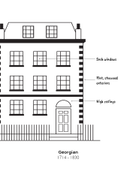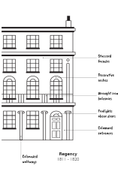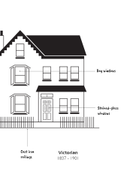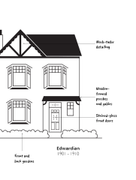
A guide to period architecture in London
Looking to buy or sell a period property? KFH experts have a deep understanding of these character homes and their place in London’s history.
6 August, 2025
The enduring appeal and popularity of period properties lies in their tangible link to our Capital’s rich past. From their form and fabric to their unique features and London locale, they offer a fascinating glimpse into the life and times of those who came before.
KFH’s sales experts have extensive knowledge of London that extends to the historical context and architectural styles of its postcodes and streets, says Sales Director for South East London Julian Peak. ‘Understanding a property’s storied past can make all the difference when it comes to positioning it on the market and maximising its potential to buyers.’
If I were selling my most prized asset, I would want to instruct the agent with the most amount of knowledge.
Why period properties are popular in London?
'If I were selling my most prized asset, I would want to instruct the agent with the most amount of knowledge,’ he continues. ‘When a KFH branch director values an Edwardian house, for example they could be up against five or six other estate agents, but they’ll never lose an instruction on that house because they will be able to optimise the value of it for the vendor thorough their architectural expertise.’
Expert insights on selling period homes
London has a wealth of sought after period housing with original features and it’s important to market their characterful qualities and charm. ‘These features carry a premium,’ says Julian. ‘So it’s crucial that as agents, we know how to differentiate between the different periods, the aesthetic of a house, and the legacy of the streets around it.’
From Georgian uniformity and Regency grandeur through to Victorian ornamentation and Edwardian craftsmanship, uncover London’s key periods and styles…
Georgian period (1714 - 1830)
Named after the reign of George I through to George IV, the Georgian period saw a great increase in building and town planning. Buildings constructed during the reign of William IV from 1830 to 1837 are referred to as Late Georgian.
Harmonious proportions
Featuring temple inspired entrances, decorative arches and Palladian columns, Georgian houses were inspired by classical Greek and ancient Roman architecture, with elegant and comfortable proportions, clean lines and a heightened sense of space and light.
‘The Georgians had an obsession with symmetry and balance,’ says Julian. ‘If you look at their smart exteriors, you have the door in the middle, with sash windows on either side. They typically feature three or four floors with smaller windows on the third and fourth floors where the staff lived and kitchens on the lower ground floor.’
What are the distinctive features of Georgian homes?
- Flat, stuccoed exteriors
- High ceilings
- Decorative ceilings and panelling
- Marble fireplaces
- Wide hallways
- Ornate mouldings
- Sash windows
Georgian properties in London
Georgian terraces in London are typically built around stately squares like those in W1 – the iconic Grosvenor, Cavendish and Berkeley Squares in Mayfair. Kennington’s Cleaver Square was the first to be built south of the river in 1789.

With the Napoleonic War, mass unemployment, food shortages, and the expansion of the slums, it was a time of huge upheaval.
Regency period (1811 - 1820)
The Regency period was born out of the Regency Act of 1811 when King George III’s eldest son the Prince of Wales was appointed to rule as Prince Regent during the madness of his father.
Regency excess
The neoclassical terraces and crescents of the Regency period follow the symmetry of the early Georgian period, but are far more flamboyant.
Built to impress and flaunt wealth and power, palatial townhouses and villas had impressive hallways, several reception rooms and highly ornamental interiors that embraced an exotic mix of Gothic, Greek, Oriental and Indian revival styles.
‘With the Napoleonic War, mass unemployment, food shortages, and the expansion of the slums, it was a time of huge upheaval,’ says Julian. ‘Yet you had disparity of the upper classes living in opulent, tremendously expensive properties influenced by European style, travel and the romantic movement,’
What are the distinctive features of Regency homes?
- Stuccoed facades
- Colonnaded walkways
- Decorative arches
- Bow windows
- Columned entrances
- Pediments and fanlights above doors
- Wrought iron balconies
Regency properties in London
Regency architect John Nash built most of Regent’s Park and Regent Street. Elsewhere, there are beautifully preserved Regency homes in Belgravia’s Eaton Square, Bloomsbury’s Bedford Square, the area around Portobello in Notting Hill and The Paragon in Blackheath.

With the introduction of the Metropolitan Railway in 1863 that marked the beginning of the London Underground, areas like Battersea and Clapham boomed...
Victorian period (1837- 1901)
Named after Queen Victoria, the Victorian period of architecture gave rise to one of the most prolific eras of building in London. The Industrial Revolution, technological advances and a burgeoning population resulted in millions of houses being built.
Ornamental and elaborate
Victoria’s reign spanned 60 years of overlapping revival styles – from the turrets and towers of Gothic Revival through to the more graceful Queen Anne style that outlived the Victorian era from 1880 until 1910.
There was an emphasis on maximalist decoration - pitched roofs with ornate trims, elaborate entrance porches, grand staircases, carved wood panelling, ceiling roses and cornicing in motif patterns, and decorative brass fixtures.
The railway network played a crucial role in the urban expansion says Julian: ‘With the introduction of the Metropolitan Railway in 1863 that marked the beginning of the London Underground, areas like Battersea and Clapham boomed with everything from rows of identikit worker’s cottages to grand detached lodges around the commons.’
What are the distinctive features of Victorian homes?
- Red brick construction
- High pitched roofs – ideal for conversion
- Cast iron railings and fireplaces
- Bay windows
- Stained glass
- Picture and dado rails
- Tiled hallways
Victorian properties in London
You’ll find fine Victorian architecture all over London, but particularly handsome are the red brick houses on Balham’s Heaver Estate Conservation Area and the leafy avenues of Bedford Park in Chiswick. Large Victorian homes also line the streets of Finchley.

Set back from busy roads and with spacious gardens, Edwardian houses are well suited to families.
Edwardian period (1901 – 1910)
The reign of King Edward VII and beyond until 1914 saw a style of architecture heavily influenced by the Arts & Crafts movement that favoured wider proportions, simple lines, high quality materials, and an appreciation for craftsmanship.
Breathing space
Urban overpopulation, a need for more housing and a desire for a healthier lifestyle created a shift to garden suburbs that offered homes built with an emphasis on space, light, access to gardens and fresh air.
These properties have a broader footprint, with large entrance halls, generously proportioned rooms, high ceilings, wide staircases and large windows to maximise natural light.
Less ornate than their predecessors, they feature handcrafted elements like carved panelling and stained glass. ‘Set back from busy roads and with spacious gardens, Edwardian houses are well suited to families, says Julian. ‘There’s no need to put huge extensions on the back or convert the lofts, as there is already plenty of living space in these amazing homes.’
What are the distinctive features of Edwardian homes?
- Mock Tudor timber detailing
- Wooden-framed porches and gables
- Stained glass front doors
- Wooden fireplaces with tiled inserts
- Botanical decorative motifs
- Parquet wood flooring
- Front and back gardens
Edwardian properties in London
London has some fine Edwardian suburbs, including the terraces and villas of the Corbett Estate and the wide streets of the Culverley Green Conservation Area, both in Catford. Much of Muswell Hill is designated a Conservation Area for its Edwardian homes developed by builder James Edmonson and architect William Jefferies Collins.

Interested in buying or selling a period property in London?
Our residential sales experts have a wealth of advice to share on period homes in the Capital.